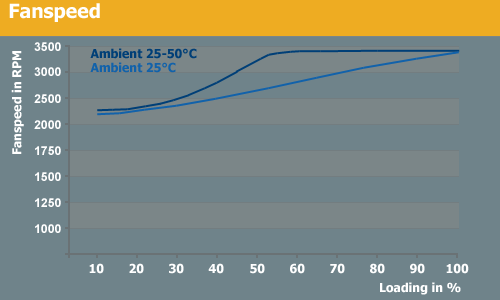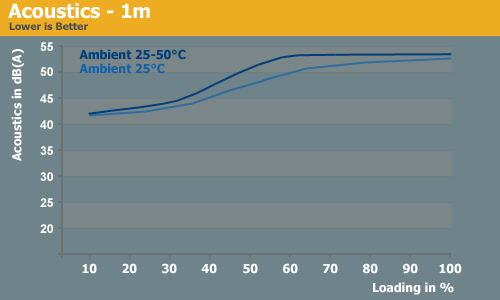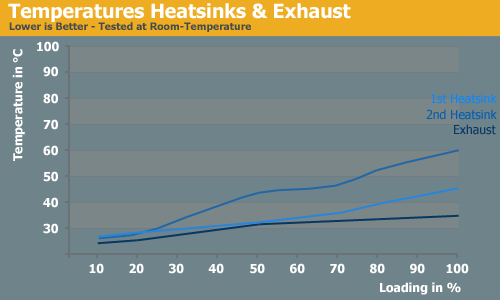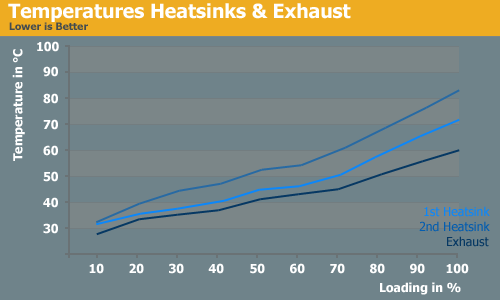Zippy Gaming G1 (GSM-6600P): Hybrid or Fence-Sitter?
by Christoph Katzer on August 3, 2007 2:30 AM EST- Posted in
- Cases/Cooling/PSUs
Fan Speed, Acoustics, and Temperatures

There are flaws visible with the 80mm fan design. As we have seen previously with the PC Power & Cooling Silencer, 80mm fans can often be quite loud even at lower loads. If the load increases the 80mm fans can kick into "hair-dryer mode", and while that may not be a major problem in a data center that's not generally something most people want sitting under their desk. Zippy appears to have taken their fan speed approach from their server designs, and it spins faster and increases RPMs much earlier than what we see in many other consumer PSUs. However, as we'll see on the temperature graphs, it is clearly necessary for them to increase fan speed as the temperature is rising steadily.

The fan starts at 2250 RPM which is already fast and loud. At 42dB(A) this power supply is far from being quiet and can easily be heard whenever it's in use. At 50% load under higher temperatures the fan is already at its maximum speed: around 3400 RPM and a noise from 54dB(A). Unfortunately, at lower room temperatures the noise levels aren't any better than at higher temperatures.


The heatsinks reach up to 60°C in a normal room temperature environment, and up to 83°C while running at 50°C ambient temperature. The design dissipates heat quite well but it's not good enough as temperatures increase steadily even with the high fan RPMs. It appears that the shape and size of the heatsinks is not sufficient to keep temperatures down, and the little noisy fan can't quite keep up.

There are flaws visible with the 80mm fan design. As we have seen previously with the PC Power & Cooling Silencer, 80mm fans can often be quite loud even at lower loads. If the load increases the 80mm fans can kick into "hair-dryer mode", and while that may not be a major problem in a data center that's not generally something most people want sitting under their desk. Zippy appears to have taken their fan speed approach from their server designs, and it spins faster and increases RPMs much earlier than what we see in many other consumer PSUs. However, as we'll see on the temperature graphs, it is clearly necessary for them to increase fan speed as the temperature is rising steadily.

The fan starts at 2250 RPM which is already fast and loud. At 42dB(A) this power supply is far from being quiet and can easily be heard whenever it's in use. At 50% load under higher temperatures the fan is already at its maximum speed: around 3400 RPM and a noise from 54dB(A). Unfortunately, at lower room temperatures the noise levels aren't any better than at higher temperatures.


The heatsinks reach up to 60°C in a normal room temperature environment, and up to 83°C while running at 50°C ambient temperature. The design dissipates heat quite well but it's not good enough as temperatures increase steadily even with the high fan RPMs. It appears that the shape and size of the heatsinks is not sufficient to keep temperatures down, and the little noisy fan can't quite keep up.










16 Comments
View All Comments
Super Nade - Friday, August 3, 2007 - link
I wonder if you guys have access to 2900XT's and a quad to actually test this unit?I would have to disagree with you on comparing Seasonic to Zippy. Most currently available data suggests that Seasonic won't match up in terms of voltage regulation (ex: 's data and JonnyGURU's data).
Lack of connectors can be a shortfall, but I'm not sure if anything else really matters. I suppose we are looking at things from different perspectives. From an Engineering standpoint, I love the Zippy. That is how I look at things. EMI, good surge protection, resonant Q-Filter on the input, an MOV ... and everything else that leads to workhorse performance is how I look at it.
JarredWalton - Saturday, August 4, 2007 - link
Just turning off the highlighting (white text).Bjoern77 - Friday, August 3, 2007 - link
It's nice to see some different power supplies tested, and not again a Infiniti 720W test ;)(though i'd appreciate a 650w infinity test, since i'm currently choosing between the 650W Infiniti and the Seasonic 650w Energy plus)
And i wish Anandtech would put out reviews and guides at at least half the speed you do - ok, a bit unfair, since you review one by one.
Keep going,
B.
Bozo Galora - Friday, August 3, 2007 - link
Well, no one can say this review has a sugar coated conclusion - lolIts nice to know you can tell it like it is, even tho you are reviewing a unit that Zippy themselves sent, not one that you purchased retail.
wolfman3k5 - Friday, August 3, 2007 - link
Good review, really do appreciate it. This is the kind of product I like reviewed, not Enermax 500 Watt PSU that anyone can get their hands on. Heck, even the shop down the street from me had Enermax Liberty PSUs in stock. Zippy makes decent enthusiast/server PSUs, how ever I prefer to stick to my PC Power & Cooling Quad 750W. Keep up the good work guys, and thanks again for the review.Talcite - Friday, August 3, 2007 - link
I love how you guys have these new reviews on the PSUs but I sure miss the oscilloscope readings that other sites have posted. Is your chroma tester capable of also putting one of those out?None of your graphs realistically depict spikes and sags in the voltage, only the average obtained in the long run. I was under the impression that the ATX specs require PSUs to be within a specified range for both sustained voltage changes and instantaneous voltage changes.